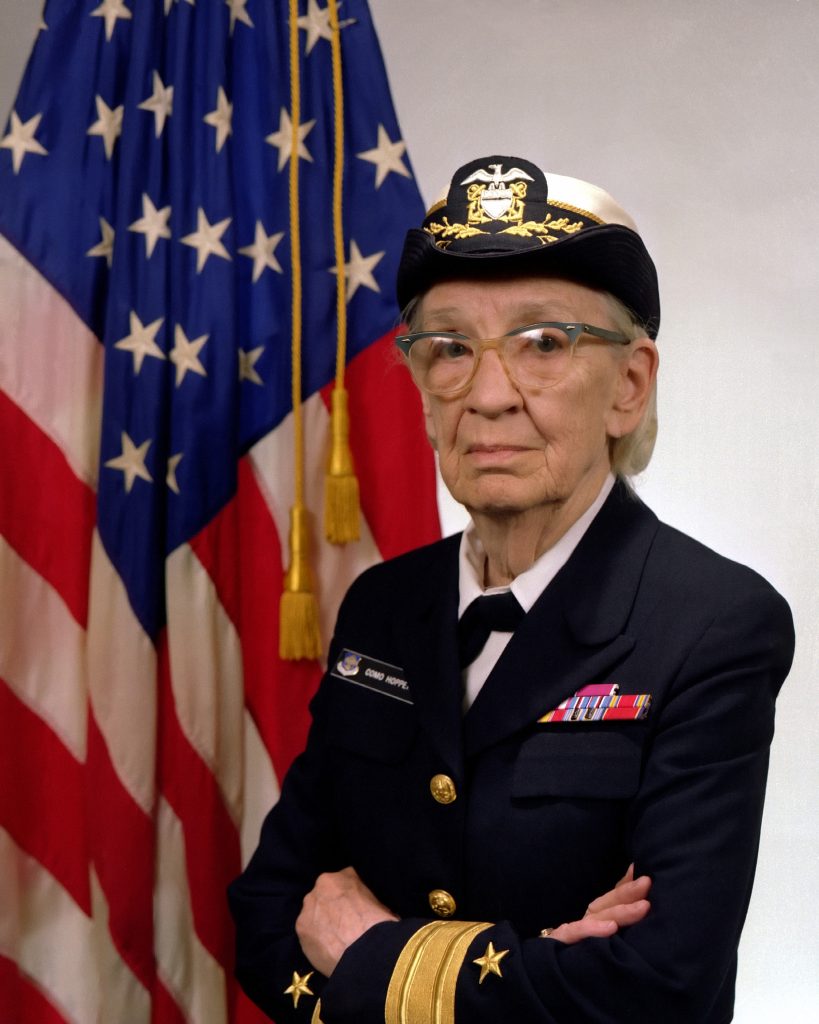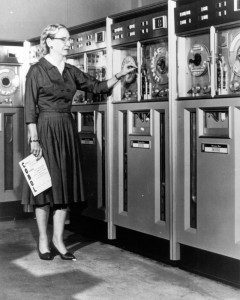Amazing Grace
She was the first woman to earn a Ph.D. in mathematics from Yale. She taught at Harvard, pioneered one of the first computer programming languages, discovered the first computer “bug,” and retired as the Navy’s highest-ranking, longest-serving female officer in history. There’s even a destroyer that bears her name.
In 2016, President Obama awarded her a posthumous Medal of Freedom, the nation’s highest civilian honor.
Hopper didn’t let military bureaucracy inhibit her trailblazing efforts. “If it’s a good idea, go ahead and do it,” she famously quipped. “It is much easier to apologize than it is to get permission.”
Coming from a family with strong military ties may account for some of her crisp self-assuredness. The oldest of three children, Grace Bre wster Murray was born in New York City on December 9, 1906. From early on, she displayed uncommon curiosity, taking apart seven alarm clocks at age 7 to see how they worked before her mother discovered what she was doing and limited her to one clock.
wster Murray was born in New York City on December 9, 1906. From early on, she displayed uncommon curiosity, taking apart seven alarm clocks at age 7 to see how they worked before her mother discovered what she was doing and limited her to one clock.
Hopper, who attended prep school, graduated from Vassar College in 1928 and married Vincent Foster Hopper, a New York University professor, two years later. She went on to study under algebraist Oystein Ore at Yale, receiving a Ph.D. in 1934, and taught math at Vassar from 1931 to 1943, when, like many other women during World War II, she joined the Navy’s WAVES (Woman Accepted for Voluntary Emergency Service). Commissioned as a lieutenant junior grade in 1994, Hopper was assigned to the Bureau of Ordnance Computation Project at Harvard University, where she became the third person on the research team that invented the first computing machine under Prof. Howard Aiken, a naval reservist. “Where the hell have you been?” Aiken asked. Pointing to his electromechanical Mark I computing machine, he said, “Here, compute the coefficients of the arc tangent series by next Thursday.”
Hopper dove in and learned to program the machine, which was 51 feet long, eight feet high, eight feet deep, and had 72 words of storage. It could perform three additions a second. She also assembled a 500-page operations manual for the Automatic Sequence-Controlled Calculator that outlined the fundamental operating principles of computing machines. She also developed the revolutionary concept of the compiler, an intermediate program that translated instructions written in English into code understood by computers.
War’s end also brought the end of Hopper’s marriage. (Though childless, she kept her husband’s name.) By then, Hopper was working on the Navy’s Mark II version of the machine. Harvard appointed her to the faculty as a research fellow, and in 1949 she joined a newly formed company that eventually became Sperry-Univac, the computer company. (Photo, left, shows Hopper with the original UNIVAC.)
Like any invention, the early computers had glitches. One was resolved in 1947 by extracting a two-inch moth from Relay #70 of the Mark II, which Hopper pasted into the log book. “From then on, when anything went wrong with a computer, we said it had bugs in it,” Hopper told Time magazine in 1984. Her work in the 1950s led to the development of the COBOL programming language.
 Hopper’s research kept her in close contact with the military, industry, academia and business. Though she had retired from the reserves at the end of 1966, the Navy recalled her to active duty eight months later, assigning Hopper — by then a commander — to the Navy Programming Languages Group, where she oversaw efforts to maintain uniformity among computer languages. She was promoted to Captain in 1973, Commodore in a 1983 White House ceremony, and Rear Admiral in a 1985. Hopper turned 80 the next year and retired from the Navy, but remained active in industry and education until her death on New Year’s Day, 1992.
Hopper’s research kept her in close contact with the military, industry, academia and business. Though she had retired from the reserves at the end of 1966, the Navy recalled her to active duty eight months later, assigning Hopper — by then a commander — to the Navy Programming Languages Group, where she oversaw efforts to maintain uniformity among computer languages. She was promoted to Captain in 1973, Commodore in a 1983 White House ceremony, and Rear Admiral in a 1985. Hopper turned 80 the next year and retired from the Navy, but remained active in industry and education until her death on New Year’s Day, 1992.
Throughout her career, Hopper confronted intellectual and social barriers. Some scholars couldn’t envision a machine ever doing more than just counting. High-ranking females were as rare in the military as snow in Miami— and Hopper was a math whiz, too. How did she get ahead in this man’s world? Brains and humor. “Humans are allergic to change,” she once noted. “They love to say, ‘We’ve always done it this way.’ I try to fight that. That’s why I have a clock on my wall that runs counter-clockwise.”
Hopper lived long enough to see her work recognized and celebrated. But decorations weren’t something on which she dwelled. As she put it: “I’ve always been more interested in the future than in the past.”
Filed under: Special Features
Tags: Computer Engineering, Computer Programming, Computer Science, Engineering in History, History, Mathematics, Science, Women in Engineering, Women in Science








